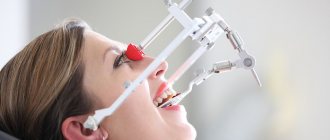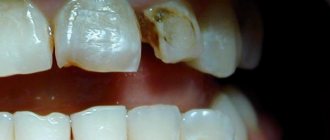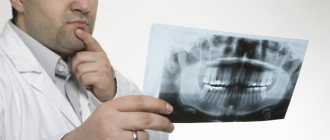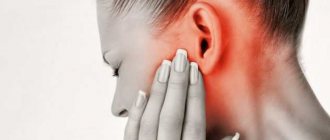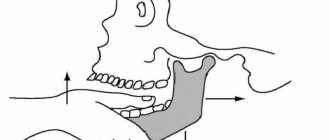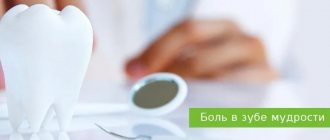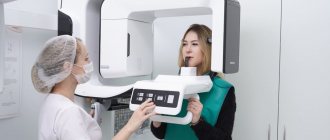Dental problems
Dental diseases
With deep caries and its complications - pulpitis, periodontitis - the pain radiates to the jaw in the area of the affected tooth.
Infectious and inflammatory processes of the soft tissues surrounding the tooth - periodontitis, abscess - cause swelling, which, by squeezing the nerve endings, provokes the appearance of painful sensations in the jaw.
With increased tooth sensitivity, eating hot, cold, spicy, sour or sweet foods and drinks, and brushing your teeth cause acute pain that spreads to the jaw.
When third premolars - wisdom teeth - emerge, complications often arise: pericoronitis, inflammation of the periosteum, one of the symptoms of which is severe pain in the jaw.
Dental treatment procedures associated with violation of tissue integrity - implantation, prosthetics, tooth extraction, installation of fillings, professional teeth cleaning and whitening - contribute to the appearance of pain in the jaw.
Bruxism
With bruxism, involuntary grinding of teeth at night significantly increases the load on the masticatory muscles, which leads to their prolonged spasm. In this case, the correct occlusion of the dentition is disrupted with the development of pain in the jaw when chewing.
Temporomandibular joint problems
If pain occurs in the jaw when opening the mouth, this is a symptom of temporomandibular joint pathology.
Pain in the projection of the jaw is often accompanied by pain in the ear, head, and face. The causes of joint dysfunction are injuries, malocclusions, incorrectly installed dentures, arthritis, arthrosis, and hypertonicity of the masticatory muscles.
Tumors of the lower jaw
Pain in the jaw area is characteristic of benign and malignant neoplasms. Benign tumors are characterized by slow growth and lack of invasion into adjacent tissues and organs.
Malignant neoplasia rapidly progresses, pain intensifies with irradiation into the eye, temporal region, ear, jaw.
Pain in the temple area
Pain in the temple area is one of the most common complaints with which patients turn to a neurologist. Modern research shows that more than 70% of the population of developed countries complain of episodic or chronic headaches in the temple area. However, this figure does not reflect the true state of affairs, since many patients do not go to doctors, self-medicating or not wanting to be examined. This leads to the development of dangerous side effects, namely:
- liver damage;
- kidney damage;
- allergies;
- gastrointestinal disorders.
Causes of pain in the temple area
Headaches in the temple area may be associated with impaired tone of the cerebral vessels of the arterial and venous beds. These may be symptoms:
- Autonomic dysfunction;
- migraine;
- increased intracranial pressure.
In older age, these are the initial manifestations of arterial hypertension and cerebral atherosclerosis. Provoking moments can be a change in weather, mental, emotional and physical overload. In this case, heaviness in the head and pressing, throbbing pain in the back of the head or temples are characteristic. The causes of pain in the temple area can be:
- Infectious diseases (various, including influenza, sore throat and many others);
- intoxication (that is, poisoning), the most familiar of which is alcohol;
Psychogenic headaches are “nervous” headaches, aching, dull, sensations that arise either in the temple, then in the back of the head, or somewhere inside. This increases irritability and fatigue. Patients complain of general “discomfort in the head,” which makes it difficult to gather thoughts and concentrate, plus a feeling of anxiety. Migraine and cluster pain are independent diseases, the main symptom of which is a severe acute headache covering one half of the head. At the same time, shiny dots (“spots”) appear before the eyes. Some people experience increased sensitivity to smells, tastes, and various external stimuli during an attack. Subsequently, patients complain of pain in one half of the head, pain in the temple, radiating to the eye.
If untreated, the pain spreads throughout the head, and nausea and vomiting often occur. Migraine headaches may be accompanied by photophobia and general weakness. Suffering lasts from 30 minutes to several hours. If the attack drags on for several days, it may end in a migraine stroke; In women, migraine is usually associated with the menstrual cycle and first makes itself felt during puberty, a period of hormonal storms. During pregnancy, the frequency of attacks decreases; after childbirth, migraines may go away forever. The causes of pain in the temples can be caused by the following reasons:
- Hormonal disorders during menopause;
- headaches in the temple area of unknown etiology;
- temporal arteritis.
It is worth noting that temporal arteritis is a rare disease in which inflammation of the walls of the temporal arteries occurs, causing excruciating severe throbbing pain in the temple area.
Pain in the temple area often indicates disruption of the cranial and spinal nerves. One of the most common symptoms of temporomandibular joint pathology . Typically, headaches due to pathology of the temporomandibular joint are located in the temple area, the back of the head, and even the shoulders (shoulder blades).
Jaw clenching and teeth grinding may be symptoms of temporomandibular joint disorder; these symptoms cause muscle pain , which may be the cause of headaches. A slipped TMJ disc can also cause pain in the joint, which often radiates to the temples, forehead, or neck. These headaches are often so severe that doctors mistake them and treat them as migraines or brain disorders.
Diet
Foods and drinks containing monosodium glutamate, which is a flavoring additive found in many processed foods; It is believed to be the cause of severe headaches. In addition, these foods in your daily diet can cause difficulty breathing and tension in the face and jaw. Pain occurs statistically in 10-15% of the population. Headache may appear 20-30 minutes after ingestion of glutamate . The pain is characterized by throbbing, dull and throbbing pain in the temple area and painful sensations in the forehead area. Products containing monosodium glutamate:
- Chinese cuisine;
- canned and dry soups;
- roasted nuts;
- processed meat;
- turkey in its own juice;
- gravies, sauces;
- some types of potato snacks and chips;
- spices and seasonings.
With a diet containing foods rich in nitrites , throbbing pain in the temple area may also occur. As a rule, half an hour after nitrites enter the body with the following food:
- Canned ham
- corned beef;
- hot dogs;
- salami;
- bologna;
- bacon;
- smoked fish.
Chocolate is one of the most powerful migraine triggers. Eating chocolate can provoke the development of hypoglycemia. Chocolate also contains caffeine, which can trigger migraines , and phenylethylamine in chocolate causes vasoconstriction, which leads to headaches in the temple area.
Firstly, chocolate provokes hypoglycemia because it contains sugar, and also because cocoa beans have a mild hypoglycemic effect. Secondly, chocolate contains caffeine, a migraine trigger. Thirdly, it contains finylethylamine, which, being an amine, causes vasoconstriction and, as a result, a headache in the temple area. It is best to limit your consumption of these foods if you notice these symptoms after eating them. If pain in the temple area is regular, it makes sense to seek help from a professional neurologist.
Causes of jaw pain not related to dental disorders
Neuralgia
When the trigeminal nerve, which is responsible for the sensitivity of the face and oral cavity, is damaged, the pain is strong, sharp, reminiscent of the pain of pulpitis. Often patients with trigeminal neuralgia undergo unnecessary dental treatment with depulpation or tooth extraction, but the pain syndrome persists.
Sialolithiasis
Salivary stone disease is characterized by the formation of stones in the ducts of the large salivary glands. Since the salivary glands are located in the mouth, pain during their inflammation also affects other nearby organs of the oral cavity, in particular the jaw.
Sinusitis
When the mucous membrane of the maxillary cavity becomes inflamed, increasing swelling and accumulation of exudate cause pain spreading to the upper jaw area from the side of the affected sinus.
Otitis
Sometimes the symptoms of otitis media are similar to toothache. With inflammation of the middle ear, pain often radiates to the jaw. The pain is sharp, shooting, aggravated by chewing and swallowing.
Submandibular lymphadenopathy
Enlargement of the submandibular lymph nodes is observed in diseases of the tonsils, acute respiratory viral infections, stomatitis, and oncological tumors. Pain under the jaw is often accompanied by limited range of motion - it is difficult for the patient to bend and turn his head, or open his mouth wide.
Diseases of the cardiovascular system
Irradiation of pain into the lower jaw can be observed during an attack of angina and myocardial infarction. A characteristic symptom of coronary heart disease is burning, pressing pain behind the sternum. But with an atypical course of a heart attack, retrosternal pain may be completely absent, only reflected pain comes to the fore: in the left arm, in the neck, in the face, in the jaw.
Causes of pain on the right side of the head and eyes
Of the main reasons, several main ones can be identified, but it is worth remembering that prolonged headache discomfort cannot be ignored, especially when it causes severe discomfort.
Main reasons:
- Severe fatigue and overstrain . Discomfort in the head, sometimes strong pulsation and discomfort in the eyes. May occur due to working at a computer or TV. This condition usually occurs in the morning or evening, and is accompanied by tingling in the temples and forehead.
- Various bruises ( blows, concussion ). Even a small blow can cause a concussion and further development of brain diseases.
- Eye diseases (glaucoma). Maybe in one eye, which causes a lot of discomfort. They usually cause the eye to tingle and become blurry.
- Incorrectly fitted glasses or contact lenses. If there is discomfort in one or both eyes, it can cause migraines, tearing and fatigue.
- Spasms of blood vessels . As a result of improperly performed physical exercises, a clamp or damage to a blood vessel can be created in the cervical spine. This will further cause discomfort in the head on the right side, as well as small hemorrhages, which cause migraines and discomfort on the right side. But at the same time, the patient feels nausea, lethargy, and inability to concentrate.
- Very often, athletes suffering from osteochondrosis suffer from headaches, as well as dizziness, neck discomfort, and pain in the eyes. Such symptoms can occur on the right or left, periodically weakening and intensifying.
Brain tumors, meningitis, pre-stroke conditions, and intracranial hematoma are also possible causes of discomfort.
Painful sensations from tumors do not depend on its size, but in addition to unpleasant sensations in the head on the right side, the patient:
- loses weight quickly,
- suffers from seizures
- In the morning the patient may feel nauseous.
Keep in mind! Migraines can occur in people between 25 and 45 years of age. In this case, the discomfort is reflected in one part of the head, affecting pain in the eyes.
This may cause a cramp or slight tingling in the limbs.
Migraines include a serious disease called hemicrania, which often affects women. The discomfort from such a disease is very strong, and externally, the pupils of the eyes become very narrow, and the eyes themselves become very red.
Pain in the right side of the head and right eye can also hurt due to an eye injury, as well as due to
an infectious disease .
And also for colds and breathing problems. If the vessels are damaged, a person who complains of discomfort on the right side of the head may also report pain under the right eye.
Diagnostics
When there is pain in the jaw, the patient first seeks advice from a dentist.
A dental examination includes the following steps.
- Clarifying patient complaints and collecting anamnesis. Since the main complaint is pain in the jaw, the time of its appearance (at night, during the day), the nature of the pain (sharp, dull, pulsating, aching), and duration (constant, paroxysmal) are specified.
- Examination of the oral cavity with assessment of the condition of the mucous membrane, tongue, gums, determination of the type of bite.
- Examination of the surfaces of all teeth using a probe and mirrors, identifying the integrity of the dentition, detecting defects in the hard tissues of the teeth.
- The percussion method is used to determine caries complications.
- Thermodiagnostics is used to identify pain reactions.
